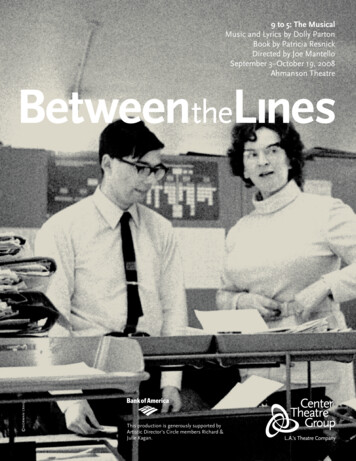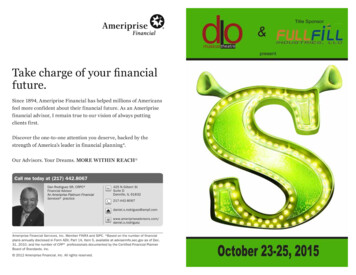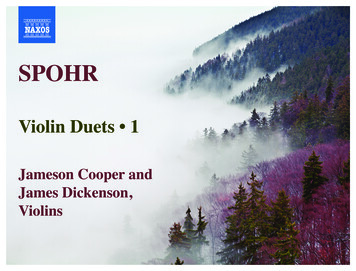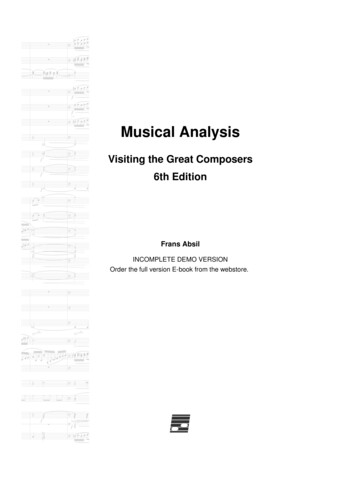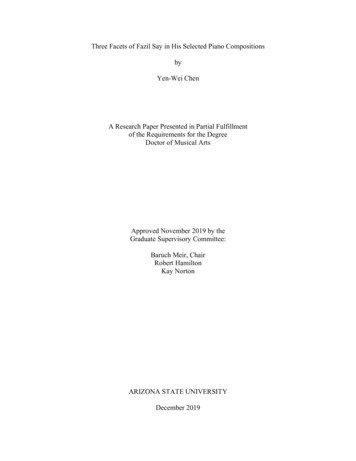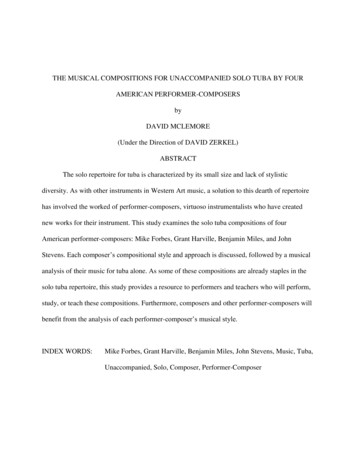
Transcription
THE MUSICAL COMPOSITIONS FOR UNACCOMPANIED SOLO TUBA BY FOURAMERICAN PERFORMER-COMPOSERSbyDAVID MCLEMORE(Under the Direction of DAVID ZERKEL)ABSTRACTThe solo repertoire for tuba is characterized by its small size and lack of stylisticdiversity. As with other instruments in Western Art music, a solution to this dearth of repertoirehas involved the worked of performer-composers, virtuoso instrumentalists who have creatednew works for their instrument. This study examines the solo tuba compositions of fourAmerican performer-composers: Mike Forbes, Grant Harville, Benjamin Miles, and JohnStevens. Each composer’s compositional style and approach is discussed, followed by a musicalanalysis of their music for tuba alone. As some of these compositions are already staples in thesolo tuba repertoire, this study provides a resource to performers and teachers who will perform,study, or teach these compositions. Furthermore, composers and other performer-composers willbenefit from the analysis of each performer-composer’s musical style.INDEX WORDS:Mike Forbes, Grant Harville, Benjamin Miles, John Stevens, Music, Tuba,Unaccompanied, Solo, Composer, Performer-Composer
THE MUSICAL COMPOSITIONS FOR UNNACOMPANIED SOLO TUBA BY FOURAMERICAN PERFORMER-COMPOSERSbyDAVID MCLEMOREBM, University of Southern California, 2009MM, University of Michigan, 2011A Dissertation Submitted to the Graduate Faculty of The University of Georgia in PartialFulfillment of the Requirements for the DegreeDOCTOR OF MUSICAL ARTSATHENS, GEORGIA2014
2014David McLemoreAll Rights Reserved
THE MUSICAL COMPOSITIONS FOR UNACCOMPANIED SOLO TUBA BY FOURAMERICAN PERFORMER-COMPOSERSbyDAVID MCLEMOREApproved:Electronic Version Approved:Julie CoffieldInterim Dean of the Graduate SchoolThe University of GeorgiaDecember 2014Major Professor:DAVID ZERKELCommittee:ADRIAN CHILDSJEAN MARTIN-WILLIAMS
TABLE OF CONTENTSPageLIST OF EXAMPLES . viCHAPTER1INTRODUCTION .1Need for Study .32MIKE FORBES .6Analytical Observations from The Grumpy Troll and Polar Vortex .103GRANT HARVILLE .22Analytical Observations from Caprice and Suite in B-Flat Minor .274BENJAMIN MILES .34Analytical Observations from Perspectives and Contraptions .395JOHN STEVENS .45Analytical Observations from Stevens’ Solo Tuba Compositions .526COMMONALITIES AND DISTINCTIONSBETWEEN THE PERFORMER-COMPOSERS .60Concluding Remarks .72BIBLIOGRAPHY .74APPENDICESA INTERVIEW WITH MIKE FORBES.76B INTERVIEW WITH GRANT HARVILLE .100iv
C INTERVIEW WITH BENJAMIN MILES .111D INTERVIEW WITH JOHN STEVENS .122E LECTURE RECITAL SCRIPT .131v
LIST OF MUSICAL EXAMPLESPageExample 1: Forbes, The Grumpy Troll – measures 1-2.11Example 2: Forbes, The Grumpy Troll – measure 4 .11Example 3: Forbes, The Grumpy Troll – measure 14 .12Example 4: Forbes, Polar Vortex – measure 1 .12Example 5: Forbes, Polar Vortex – measure 16 .12Example 6A/6B: Forbes, The Grumpy Troll – measures 88-89 & 97-98 .13Example 7: Forbes, Polar Vortex – measures 102-103 .14Example 8: Forbes, The Grumpy Troll – measures 49-51 .14Example 9: Forbes, Polar Vortex – measures 40-43.15Example 10: Forbes, The Grumpy Troll – measure 46 .18Example 11: Forbes, The Grumpy Troll – measure 37 .19Example 12: Harville, Caprice – measures 1-5 .28Example 13: Harville, Caprice – measure 25 .28Example 14: Harville, Caprice – measures 7-10.29Example 15: Harville, Suite in B-flat Minor, 2nd movement – measures 16-17 .31Example 16: Miles, Perspectives – measures 1-4 .39Example 17: Miles, Contraptions, “Roller Coaster” – Measures 1-2 .39Example 18: Miles, Contraptions, “Conveyor Belt” – Measures 21-23 .40vi
Example 19: Miles, Contraptions, “Hot Air Balloon” – Measures 1-2 .40Example 20: Miles, Perspectives – Measures 38-45 .41Example 21: Miles, Perspectives – Measures 23-30 .41Example 22: Miles, Perspectives – Measures 98-101 .41Example 23: Miles, Contraptions, “Hot Air Balloon” – Measures 16 .43Example 24: Miles, Contraptions, “Conveyor Belt” – Measures 49-50 .44Example 25: Miles, Contraptions, “Conveyor Belt” – Measure 52 .44Example 26: Stevens, Remembrance – Measures 1-4 .53Example 27: Stevens, Salve Venere, Salve Marte – Measures 1-3.53Example 28: Stevens, Elegy – Measures 56-59 .55Example 29: Stevens, Triumph of the Demon Gods – Measure 53 .56Example 30: Stevens, Salve Venere, Salve Marte - 9-6 measures before rehearsal letter L.57Example 31: Stevens, Remembrance – Measure 46 .57Example 32: Stevens, Salve Venere, Salve Marte – Rehearsal G .58Example 33: Stevens, Remembrance – Measures 112-117 .58vii
CHAPTER 1INTRODUCTIONThe solo repertoire for the tuba is far younger and smaller than that of most otherinstruments in western art music. This is a result of the tuba’s relatively young age, having beeninvented in the mid-19th century, as well as the lack of solo works for tuba prior to the middle ofthe 20th century. In 1954 and 1955 the first major tuba sonata and concerto were published,respectively Paul Hindemith's Sonata for Tuba and Piano and Ralph Vaughan Williams'Concerto for Bass Tuba in F minor. These compositions marked the first time that well-knowncomposers in western art music treated the tuba as a legitimate solo instrument. Following thesepublications, composers began to take an interest in the tuba as a viable solo voice but, at only 60years of age, the solo repertoire for tuba remains among the youngest and smallest among theorchestral wind instruments in western art music.Naturally, this places limitations on the stylistic breadth of solo repertoire available to thetubist. The repertoire does not have the benefit of shifting stylistic periods which generate aconsiderable variety of musical material in the solo repertoire of other instruments. The horn, forinstance, possesses a solo repertoire spanning several stylistic periods in western music,including the Baroque, Classical, Romantic, and Contemporary periods. The tuba, bycomparison, only occupies the latter half of the 20th century going forward, meaning that tubaplayers wanting to perform works in the Baroque, Classical, or Romantic styles must eitherperform either solo works written for tuba that imitate earlier periods, or transcribed worksoriginally written for other instruments or voices which originate from earlier musical periods.1
This problem, of course, isn't unique to the tuba; many instruments in western art musichave dealt with a relative lack of repertoire at some point, either in terms of a lack of stylisticdiversity or a scarcity of solo compositions in general. Musicians on various instruments, likemodern tubists, have transcribed music as one method for solving this issue. However, virtuosoperformers in particular developed another method for broadening the repertoire: composing newmusic themselves for their instrument or voice. The contributions by these performer-composersto solo repertoire for their instruments constitute an interesting aspect of the history of westernart music, one relevant in the discussion of limitations to said repertoire.There are numerous examples of performer-composers in music history who madesubstantial and noteworthy additions to the repertoire of their instrument. Franz Liszt andFrederick Chopin were Romantic era composers as well as virtuoso pianists; their works for solopiano constitute their compositional output as performer-composers. Franz Liszt was a Romanticpiano virtuoso and composer who expanded the piano solo repertoire in two ways: by creatingoriginal compositions for piano in a virtuosic style, and by crafting piano transcriptions and ofearlier orchestral and operatic works, such as the symphonies of Beethoven. Likewise, Chopin'scompositional output favors the piano, expanding the piano repertoire through the compositionof mazurkas, ballades, nocturnes, and concert etudes, which had earlier been developed by Liszt.Niccolo Paganini was a violin virtuoso who composed original compositions for himselfto play in concerts, such as the 24 Caprices. These compositions not only expanded the solorepertoire for violin but in fact caused violin technique to evolve; this was due to the extensivetechnical requirements and varied timbres called for in Paganini's violin compositions.1 For theNeill, Edward, "Paganini, Nicolò," Grove Music Online, Oxford Music Online Oxford University 08 (accessedOctober 16, 2014).12
horn, Franz Strauss is a noteworthy performer-composer, having simultaneously performed as avirtuoso and composed works for the horn's solo repertoire, such as the Nocturno. J.S. Bach andBeethoven were themselves also performer-composers, with regards to particular subsets of theircompositional output. The organ and keyboard works of Bach, including numerous toccatas,preludes, chorale preludes, fantasias, and fugues, were likely informed by his experienceperforming as a church organist. In the case of Beethoven, his sonatas, concertos, and othercompositions for piano were likely informed by his experience of playing the piano as a child,specifically with regards to his knowledge of the instrument's capabilities.Similarly to the examples listed above, tuba performers have also augmented the solorepertoire for their instrument by composing new works, effectively becoming performercomposers. The relative lack of solo repertoire has provided an opportunity for performers whomare also skilled at music composition to contribute to the tuba's solo repertoire. In this paper, Iwill examine the work of four American performer-composers and their unaccompaniedcompositions for solo tuba: Mike Forbes, Grant Harville, Benjamin Miles, and John Stevens.These four tubists have each composed multiple works for the tuba alone, some of which arealready staples within the solo repertoire. By composing original works for their instrument, theycontinue a traditional element within western art music: the expansion of solo repertoire throughnew works created by performers.Need for StudyThis study is necessary for several reasons, not the least of which is to expand theacademic literature discussing performer-composers and their compositions. While there existsmuch scholarship pertaining to performer-composers for other instruments, there are nodissertations which address the topic of unaccompanied solo tuba compositions by American3
performer-composers; in fact, there aren't even dissertations which discuss unaccompanied tubacompositions in more general terms. Of the four American performer-composers discussed inthis paper, only one appears in the existing scholarly literature: John Stevens. However, thedissertation literature addressing Stevens pertains to his compositions for solo euphonium, forbrass quintet, and for tuba with orchestra, but not to those for solo alone.2 This dissertation willaddress these performer-composers, their contributions to the solo repertoire for tuba, theirprocess and approach to writing music, and how their experience as a performer informs theirapproach as a composer. At the same time, this paper will also expand the existing, wellestablished literature on performer-composers.As was mentioned previously, some of the pieces examined in this study are alreadypopular staples in the solo tuba repertoire, while others are relatively new compositions just nowbeing introduced to the tuba community. Tubists seeking to perform these works havetraditionally been left to their own devices in analyzing and understanding the compositions,since virtually none of these works are discussed in existing academic literature. This paperpresents an opportunity both to examine established and new solo tuba works by performercomposers, and to compare the pieces and their associated compositional styles andcharacteristics. In doing so, this dissertation will serve as a resource for performers seeking toperform these works from an informed, musical perspective. At the same time, composerslooking to write for the tuba and tubists considering composing for the tuba themselves will alsoSpringer, Mark Alan, “A performance and rehearsal guide to two contemporary brass quintets: ‘ColchesterFantasy’ Dr. Eric Ewazen, ‘Seasons: A Symphony for Brass Quintet’ John D. Stevens,” DMA dissertation, TheUniversity of Wisconsin-Madison, 1999. Daussat, David M., “Birth of a modern concerto: An explication of musicaldesign and intention in Journey: Concerto for Contrabass Tuba and Orchestra,” DMA dissertation, University ofNorth Texas, 2008. Mirales, Matthew, “Premiere euphonium recordings of solo music composed by John Stevens,”DMA dissertation, The University of Wisconsin – Madison, 2013.24
find this to be a valuable resource, as it highlights the processes and considerations these fourperformer-composers consider when writing music for unaccompanied tuba.The methodology for this paper consisted of two parts: interviewing the four performercomposers, and then analyzing their compositions for solo tuba. The interviews occurred eitherin person, over telephone, or via Skype, depending upon the preference of each composer. Ineach case, the interview was recorded so that a written transcript could be produced afterwards.The composers were asked a variety of questions pertaining to their unaccompanied tubacompositions and their compositional style, in general and with regard to these pieces. Themusical analysis of each composer's unaccompanied compositions was general in approach,focusing on important elements of each performer-composer's musical style. These stylistic traitssometimes, though not always, confirmed composer’s self-descriptions regarding compositionalapproach and characteristics.The following sections will address each performer-composer individually. Eachcomposer’s compositional approach for the tuba will be analyzed and discussed, with relevantmusical examples drawn from their compositions.5
CHAPTER 2MIKE FORBESMike Forbes, is an accomplished musician and composer with a multifaceted career as atubist, performing in both large and chamber ensembles. Forbes began his performance careerplaying with the United States Army Band (“Pershing’s Own”), and later founded the IsthmusBrass, a prominent large brass ensemble based in Wisconsin. He is also a co-founder of SottoVoce, one of the premiere American professional tuba-euphonium quartets. Forbes is currentlyprincipal tubist with the La Crosse Symphony, and is also in demand as a soloist and clinician.Forbes has served as guest lecturer in residencies in Spain and Portugal, and frequently performsat colleges and conferences domestically and internationally. He has released two solo albums,Forbes Plays Koetsier and Forbes Plays Forbes; the latter features his own solo compositionsfor the tuba.3As a composer, Forbes is regularly commissioned and has written compositions forvarious mediums, ranging from solo works for tuba and other instruments to works for windbands and orchestras of varying skill levels. He works as a low brass specialist for KendorMusic, as well as a middle and high school band and orchestra composer for Carl Fischer andFJH Music. Forbes has won the Dallas Wind Symphony Fanfare Composition Contest multipletimes.4 He has written two unaccompanied solos for tuba: The Grumpy Troll, published in 2013,and Polar Vortex for Unaccompanied Contrabass Solo Tuba, published in 2014.“Biography,” MikeForbesMusic.com, http://www.MikeForbesMusic.com/biography.html/ (accessed October 16,,2014).4Ibid.36
Forbes considers several composers to be influences on his compositional approach. Hecites the music of Bela Bartok, Igor Stravinsky, Steve Reich, and to a lesser extent Pat Methenyas influential in terms of style and sound. Referring specifically to writing for brass instruments,he cites Edward Gregson and Phillip Sparke as influences, asserting that though he doesn’tintentionally emulate Gregson or Sparke, as a brass player in the 21st century he is inevitablyeffected by their compositional style for brass instruments5. Forbes also makes a point to listen tonewer orchestral music, citing the Milwaukee composer Michael Torke as an example of acontemporary composer whose sound he enjoys and wants to emulate on some level.6With specific regards to his unaccompanied tuba compositions, Forbes cites specificcomposers and compositions as influences. For The Grumpy Troll, Forbes claims twocompositions as specific influences: Capriccio for Solo Tuba by Krzysztof Penderecki andFnugg by Norwegian tuba virtuoso Oystein Baadsvik. In the case of Polar Vortex, the music ofJohn Stevens is cited as an influence, specifically Triumph of the Demon Gods, as well as FredClinard’s Sonata for Unaccompanied Euphonium.7 It is interesting to note that other performercomposers, Baadsvik and Stevens, are themselves influences upon Forbes and hisunaccompanied pieces for tuba.Forbes describes his compositional style as being linear in approach, one in whichimportant motivic intervals and pitch cells are used as a kernel from which to develop theentirety of a composition. In particular, he emphasizes counterpoint and the importance of therules counterpoint entails as a useful framework for his compositional approach. This is not thecase for diatonic scales and tonalities; as a general rule Forbes avoids writing pieces with aMichael Forbes, interview by author, Bloomington, IN, May 22, 2014 (Appendix A, p. 89-90).Forbes, interview (Appendix A, p. 79).7Forbes, interview (Appendix A, p. 89-90).567
particular concern for diatonic collections, because he finds this to be too restricting in hisprocess of composing. He finds that if he is writing in a specific key, he tends to stay in that keyand is never able to stray from it.8 Thus, he employs a freer compositional approach, oneemphasizing cells of intervallic and pitch content rather than harmonic pitch collections.These motivic kernels are subjected to a process of compositional improvisation, whichhelp Forbes to examine the resources available and draw them out; this improvisation is howForbes expands the motivic cells into the entire composition. For the purposes of his solo tubacompositions, Forbes’ improvisational development tends to employ the tuba exclusively,improvising musical ideas based upon the kernel while playing the tuba rather than thekeyboard.9 He does have experience playing the piano, and will use the piano or even the voiceto improvise and develop musical cells, though typically in the case of larger compositions forband or orchestra. As a general rule, Forbes feels less limited by technique when playing at thetuba, and thus prefers to compose at the tuba when writing for the instrument.Forbes’ approach to creating form and structure in his music is organic in nature; hestrives to generate form out of the same forward-building process that transforms his pitch cellsinto large-scale musical structures. As with diatonic collections, he avoids writing music in aspecific formal structure such as rondo or sonata form, because he feels that this would restricthis compositional process.10 At the same time, Forbes views musical structure as a vital aspect ofa successful piece of music, and so maintains a peripheral awareness of form while developinghis musical kernels. The end goal is to create music possessing a structural framework withoutimposing or creating that framework at the outset of the composition. Forbes asserts that musicalForbes, interview (Appendix A, p. 80).Ibid.10Forbes, interview (Appendix A, p. 91-92).898
structure is vital for a composition to be successful, and that musical structure is analogous to thestructure beneficial when raising an infant child. People tend to crave structure in their humanexistence, and for Forbes form is the musical analogue to our general need for imposed order.11Programmatic content is another prominent feature in Forbes’ music, appearing in bothof his unaccompanied works for tuba. His programs tend not to be literal in nature, such as thatof Hector Berlioz’s Symphonie Fantastique, but rather suggest the mood or atmosphere of anextra-musical idea.12 In The Grumpy Troll, Forbes is trying to express the aggression and weightof a grumpy troll, whereas in Polar Vortex he sought to musically express his reaction to thePolar Vortex storms that affected the Midwestern United States in the winter of 2013, especiallythe bitter cold associated with them. More generally, one of Forbes’ goals as a composer is tocommunicate emotions and feelings through his music, and to elicit emotional reactions from hisaudience.13 This lends itself very much to the suggestive extra-musical ideas he employs, whichinform the listener of the mood and atmosphere Forbes is attempting to portray musically.A concern for the audience and performer is another key characteristic in Forbes’approach to composing. As was discussed previously with regards to form and programmaticcontent, his goal as a composer is to appeal to the audience musically, and does so through theuse of musical structure and programs. In writing The Grumpy Troll, for example, Forbes wantedto captivate the audience, in much the same way that Oystein Baadsvik’s composition Fnuggappeals to and is popular with audiences. Forbes avoids through-composed writing devoid ofform partially because he himself dislikes it, but also because he feels it wouldn’t appeal to hisaudience. At the same time, Forbes is also concerned with the performer’s perspective,Forbes, interview (Appendix A, p. 92-93).Forbes, interview (Appendix A, p. 93).13Ibid.11129
specifically whether or not his music is idiomatic for the performer. He asserts that the mostsuccessful music is usually written by composers with an intimate knowledge of the instrumentfor which they are composing and its capabilities, as well as knowledge of the intendedperformers and their limitations. For example, when Forbes composes music for middle schoolbands, he will limit himself to the first 4 or 5 notes that each instrumentalist can play at thatlevel; though this is a considerable limitation on himself as a composer, it ensures that his musicis playable for the performers for whom he is writing.14Forbes describes a triangle of considerations for himself as a composer, each cornerrepresenting a different perspective. At one corner is himself, the interests he has as a composerand what he is attempting to express through a piece of music. At the second corner is theinterest of the audience, his concern for being able to convey emotions to the audience throughmusic that has a discernable structure. And in the third corner the performer’s perspective comesinto play, specifically Forbes’ consideration of what is idiomatic and playable for the performersof his compositions.15 Forbes argues that successful compositions balance these threeconsiderations rather than focusing on one or two exclusively, to the detriment of the third.The next section will presents analytical observations from Forbes’ unaccompaniedcompositions for tuba: The Grumpy Troll and Polar Vortex. Some of these observations reinforceForbes’ own description of his style, while others do not; the latter case reflects the reality thatcomposers are not necessarily consciously aware of every analytical feature of their music.Analytical observations from The Grumpy Troll and Polar VortexOne of the more interesting aspects of Mike Forbes’ compositional approach is his useof a specific interval to create an entire composition. For each of his unaccompanied works for1415Forbes, interview (Appendix A, p. 84-85).Forbes, interview (Appendix A, p. 98).10
Example 1: Forbes, The Grumpy Troll – measures 1-2tuba, a single interval is used to derive the vast majority of musical content on the surface andwithin the structure. In the case of The Grumpy Troll, this governing interval is the minor 3rd or[03]; for Polar Vortex the interval is the minor 9th or [01].The Grumpy Troll begins with a presentation of two pairs of minor thirds; the firstascends from D to F, while the second descends from E-flat to C (Example 1). These four pitchestogether form a [0235] tetrachord, literally a combination of two minor 3rd intervals a whole stepapart; much of the musical content found in The Grumpy Troll can be explained in terms of this[0235] tetrachord. For example, throughout the piece Forbes makes occasional use of the tritonemelodically, such as in measures 19-21. This [06] tritone can be seen as an augmentation of theminor third, since two minor thirds stacked atop one another will yield the interval off the tritone.In several passages Forbes writes chromatic passages outlining a [0123] tetrachord, which can beseen as a chromatic embellishment of the minor third (Example 2). Melodic [0257] tetrachordsappear occasionally, a quartal harmony seemingly having little to do with the minor third(Example 3). However, the [0235] structural tetrachord is outlined by [05], an interval that canbe stacked upon itself to yield the [0257] tetrachord. The whole and half steps appearing in theExample 2: Forbes, The Grumpy Troll – measure 411
Example 3: Forbes, The Grumpy Troll – measure 14Example 4: Forbes, Polar Vortex – measure 1music can also be explained by their being a part of [0235], and by extension the chromaticismused by Forbes is itself a result of compositional augmentation of the [01] semitone.Similarly, Polar Vortex also features a single interval that is of particular melodic andstructural importance, namely the minor 9th (Example 4). This interval is used by Forbesthroughout the music, both in its original form as well as in transformed versions. For instance,several passages emphasize the major 7th as much as the minor 9th; the major 7th is, of course, aninversion of the minor 9th. Chromatic half steps appear throughout the music as well, which isexplained by the fact that the minor 9th is a semitone combined with an octave displacement(Example 5). All of these intervals express an underlying [01] dyad that Forbes uses within themusical structure. Forbes also emphasizes other intervals in this work, in particular the tritoneand perfect 4th/5th, though they do not necessarily relate to the interval of a semitone. Forbescombines these intervals within the composition, yielding frequently recurring pitch class setssuch as [016], [0167], and [0156]. Polar Vortex is less homogenous than The Grumpy Troll interms
solo tuba repertoire, this study provides a resource to performers and teachers who will perform, study, or teach these compositions. Furthermore, composers and other performer-composers will benefit from





